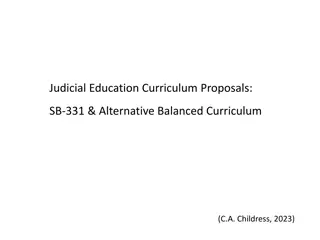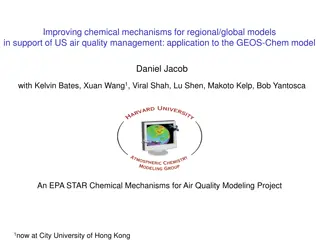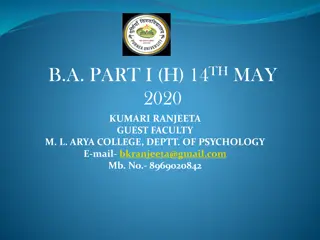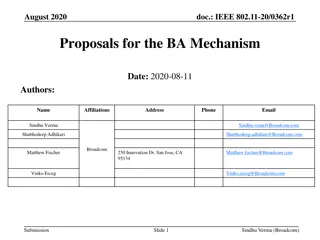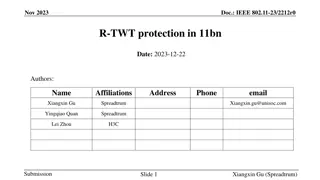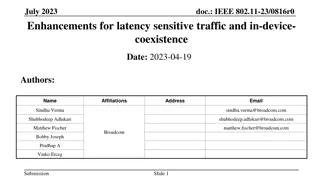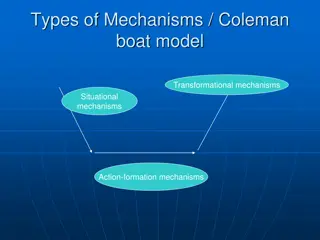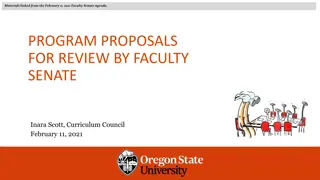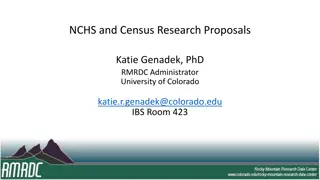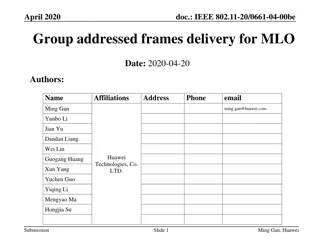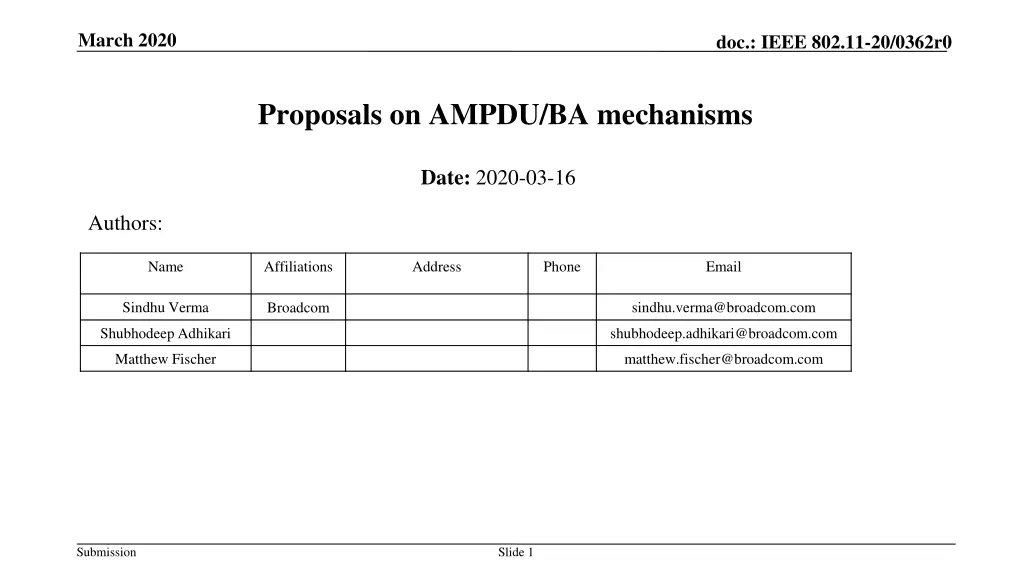
Enhancing AMPDU/BA Mechanisms for IEEE 802.11
Explore proposed changes to improve efficiency in the existing AMPDU-BA mechanisms in IEEE 802.11 standards, focusing on addressing limitations related to receiver processing, transmitter implementation, and flexibility optimizations to enhance multi-link performance.
Download Presentation

Please find below an Image/Link to download the presentation.
The content on the website is provided AS IS for your information and personal use only. It may not be sold, licensed, or shared on other websites without obtaining consent from the author. If you encounter any issues during the download, it is possible that the publisher has removed the file from their server.
You are allowed to download the files provided on this website for personal or commercial use, subject to the condition that they are used lawfully. All files are the property of their respective owners.
The content on the website is provided AS IS for your information and personal use only. It may not be sold, licensed, or shared on other websites without obtaining consent from the author.
E N D
Presentation Transcript
March 2020 doc.: IEEE 802.11-20/0362r0 Proposals on AMPDU/BA mechanisms Date: 2020-03-16 Authors: Name Affiliations Address Phone Email Sindhu Verma sindhu.verma@broadcom.com Broadcom Shubhodeep Adhikari shubhodeep.adhikari@broadcom.com Matthew Fischer matthew.fischer@broadcom.com Submission Slide 1
March 2020 doc.: IEEE 802.11-20/0362r0 Abstract This contribution discusses possible changes/enhancements to the existing AMPDU-BA mechanisms to achieve improvements in efficiency also in relation to the 802.11be multi-link feature. Submission Slide 2
March 2020 doc.: IEEE 802.11-20/0362r0 Limitations with existing AMPDU BA mechanisms (1) Related to receiver processing constraints: A receiving device must respond with BA after exactly a period of SIFS from the preceding AMPDU. A receiver may sometimes be incapable of transmitting BA after SIFS delay of AMPDU reception due to Rx-Tx switching delay A receiver may sometimes be incapable of receiving trailing MPDUs in a transmitted AMPDU due to in-device coexistence constraints and so, incapable of transmitting BA after SIFS delay A receiver may have processing constraints which prevent it from processing all the MPDUs in the preceding AMPDU and generating the BA information within SIFS period. The processing constraint could be based on the number of bytes or the number of MPDUs to be processed Note: The delayed BA mechanism was deprecated and then removed Submission Slide 3
March 2020 doc.: IEEE 802.11-20/0362r0 Limitations with existing AMPDU BA mechanisms (2) Related to transmitter implementation constraints: Implementation constraints in multi-link may require some time margin to be given for AMPDUs to be built/rebuilt This can be in consideration of which link gets access to the channel first and with how much bandwidth. A short AMPDU (even if with a duplicate MPDU) can precede the final AMPDU Inserting the SIFS+BA+SIFS gap between these 2 AMPDUs would be unnecessary and may also cause problem with synchronous MLD receivers Transmitting without rebuilding may cause unnecessary transmission of duplicate MPDUs or transmission of MPDUs with unnecessary gaps in sequence numbers Submission Slide 4
March 2020 doc.: IEEE 802.11-20/0362r0 Limitations with existing AMPDU BA mechanisms (3) Related to transmitter flexibility and other optimizations The duration/contents cannot be adjusted once the transmission of the AMPDU starts as the duration is contained in the L-SIG. Being able to adjust the duration or contents is useful in case of asynchronous operation on multi-link. This is because events on one link may impact decisions regarding transmissions on another link (one may receive BA correctly on 1 link but not on the other and in an asynchronous manner) Being able to insert latency sensitive traffic in an ongoing transmission will help latency. If the arrival of a low- latency packet is envisaged, the AMPDU can start with a conservative duration which will be followed up with an AMPDU with low latency traffic if available or otherwise, another similar AMPDU of the maximal duration For long AMPDUs, if the initial PHY header is missed, decoding fails for the receiving device and preamble detection fails for any device performing CCA The problem can be alleviated if instead of a long AMPDU, a sequence of shorter back-to-back AMPDUs without gaps can be transmitted followed by a single composite BA. Multiple MCSs/NSSs cannot be tried together and each combination must be tried one at a time followed by a corresponding feedback Convergence of the rate control algorithm can be expedited if a composite feedback can be obtained for a back- to-back AMPDU sequence with multiple MCSs/NSSs. Submission Slide 5
March 2020 doc.: IEEE 802.11-20/0362r0 Solutions for receiver capability restriction(1) Scenario: An AMPDU is transmitted to the receiver with the expectation that it will respond with BA after a SIFS delay from the end of the AMPDU. However, the receiver is incapable of sending BA exactly after a period of SIFS from the end of the AMPDU due to one of the following reasons: A. The receiver may sometimes be incapable of transmitting BA after SIFS delay of AMPDU reception due to Rx-Tx delay B. The receiver may sometimes be incapable of receiving trailing MPDUs of a transmitted AMPDU due to in-device coexistence constraints and so, incapable of transmitting BA after SIFS delay C. The receiver has constraints in processing a larger number of MPDUs and so, it cannot transmit the complete BA after SIFS delay Solutions: The receiver negotiates its limitation with the transmitter with respect to the above reasons. For each of the above reasons, the receiver negotiates the minimum delay x and the maximum delay y within which the BA will be transmitted if not after SIFS delay. For C, the receiver also negotiated the thresholds of MPDU count or bytes beyond which it cannot process to send a BA with SIFS delay For A: If the transmitter does not detect start of a preamble in the slots after SIFS delay from the end of the AMPDU, it resumes with occupying the TXOP, transmitting AMPDUs either to the same receiver (provided the BA window is not exhausted) or to another receiver or transmitting Trigger to any client. The assumption now is that BA will be transmitted using contention or can be triggered after a minimum delay x and before a maximum delay y. The expiry of maximum delay will lead to the assumption at the transmitter that the AMPDU is in error. Slide 6 Submission
March 2020 doc.: IEEE 802.11-20/0362r0 Solutions for receiver capability restriction(2) Solutions: For B: If the transmitter does not detect start of a preamble in the slots after SIFS delay from the end of the AMPDU, it resumes with occupying the TXOP, transmitting AMPDUs to another receiver or transmitting Trigger to any other client. The assumption now is that BA will be transmitted using contention or can be triggered after a minimum delay x and before a maximum delay y. The expiry of maximum delay will lead to the assumption at the transmitter that the AMPDU is in error For C: The receiver capability is negotiated in terms of the minimum delay it needs for processing MPDUs larger than a number A or bytes B. The transmitter accordingly transmits AMPDUs. If the receiver does not process all MPDUs to be able to transmit BA within SIFS delay, it responds with a special BA MPDU which indicates the last sequence number processed or the inability to have processed all the MPDUs in the AMPDU. The transmitter resumes the TXOP , transmitting AMPDUs either to the same receiver (provided the BA window is not exhausted) or to another receiver or transmitting Trigger to any client. The transmitter may continue to transmit back-to-back AMPDUs separated by SIFS or even without any gap, to the same/different receiver. The assumption now is that BA will be transmitted using contention or can be triggered after a minimum delay x and before a maximum delay y. The expiry of maximum delay will lead to the assumption at the transmitter that the AMPDU is in error. Note that the receiver will eventually send a BA, either solicited by reception of a new AMPDU, or by a BAR or transmitted by self initiation in its own TXOP - whenever it does send a BA, that BA should be cumulative in terms of ACK information. Submission Slide 7
March 2020 doc.: IEEE 802.11-20/0362r0 Solutions for transmitter flexibility Scenario: An AMPDU is transmitted to the receiver but the transmitter does not want it to respond with BA after a SIFS delay from the end of the AMPDU. The transmitter may want this behaviour irrespective of any receiver implementations. Explicitly sending such an indication will tell the receiver not to try to transmit the BA using contention at a later time for the corresponding AMPDU unless solicited Solutions: The transmitter indicates using a bit in the PHY header of the AMPDU that it does not want the receiver to send BA immediately. This may be motivated by multiple reasons: The transmitter has envisaged only this small an AMPDU for the receiver and wants to switch to another receiver. Hence, it is in no hurry to receive the BA form the receiver. The SIFS +BA+SIFS can be avoided The transmitter wants to align transmit receive directions on multiple links in its TXOP on both the links. It may even want to align transmissions to or from the same client. For the purpose of alignment itself, the transmitter may not have decoded sufficient information on one of the links to adjust the exact length of the AMPDU it transmits on the other link. It sends an intermediate short AMPDU until the information is known and follows it up with a longer AMPDU of the duration it desires. Once, this bit is decoded by the receiver, it knows not to respond with a BA after SIFS gap. If it does not have the receiver limitation B negotiated, it either expects another AMPDU to be sent with a SIFS gap or even without any gap The transmitter will elicit a composite BA at the end of a series of such transmissions when it really needs the BA. This BA can be elicited using the same bit so that it is transmitted with SIFS gap from the end of the AMPDU. Alternately, the BA will be requested for using a BAR. Submission Slide 8

